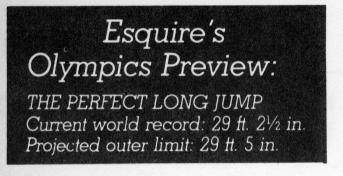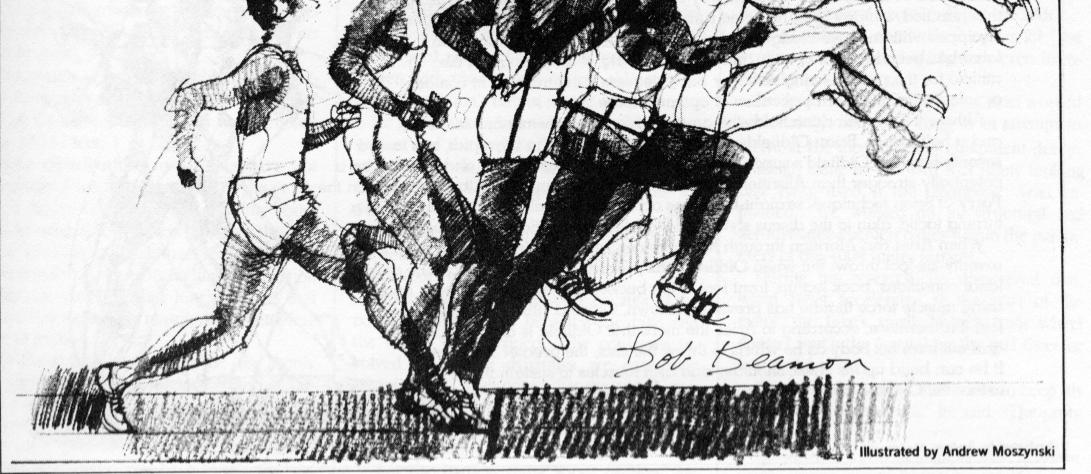| Previous | Index | Next |
he long or broad jump combines
both the sprint and the high jump in a
fusion of horizontal and vertical forces. The union of the two expressions of force optimizes at an angle somewhat less than thirty degrees from the horizontal. Theoretically the best ballistic angle would be forty-five degrees, but the angle must be cut down because an erect human starts his flight with his center of gravity already several feet off the ground. This principle, incidentally, holds true for the best angle of flight with the javelin.
Evidence of what makes near perfection in the long jump exists in the most incredible performance in the history of track and field. At Mexico City, in 1968, Bob Beamon of the U.S. jumped twenty-nine feet two and a half inches, more than a full foot beyond anything done before or since.
Using films of Beamori s jump, Ariel compared him on the computer with Randy Williams, the 1972 gold medalist. Beamon s final stride was one and a half inches longer than that of Williams. Beamon had achieved extremely high velocity just prior to takeoff. As he transmitted his horizontal force into vertical force, Beamon kept the trunk of his body very rigid. "We have thirty-two
vertebrae to absorb the shock of walking or running," remarks Ariel. "Ordinarily,
even the best long jumpers collapse the trunk slightly as they absorb the shock at takeoff in the vertebrae."
Beamon's ability to handle the forces without absorbing some in his joints is all the more remarkable since he fused the forces from various segments of his body within .075 seconds fi`om the time his foot touched the board. Other jumpers required at least one tenth of a second or more. Thus, Beamori s linkage integrated a series of motions and combined more than one hundred sources of force in a near perfect piece' of synchronization.
His free leg contributed as much as thirty-five percent to Beamori s performance because of the jumper's effective deceleration of the limb. As Isaac Newton proved, when a moving object suddenly slows, the force within it must go somewhere. For example, throw your fist in the air. Stop the punch abruptly and you will feel the force in other areas of your body. But 'if you simply permit the arm to extend fully, you will experience little sense of the force in your body. Starting with the last four positions of
Beamori s free leg, the computer diagram of Beamon shows its movement slowed radically. The deceleration force went into the jump.
Beamon's swinging arms served two functions. Prior to lift-off he deoelerated them to add more force, as with his free leg. During his flight, the arms added no power but helped retain balance.
Ariel's computer indicates Beamon rolled up 1700 pounds of force in his hip joint. Medical research suggests that at this level, the average muscle attachments to the hip will tear. Therefore, it is unlikely any human can significantly improve on the amount of force manufactured by Beamon. When Ariel put all of the data into the ideal long jump, he found that a twenty-seven-degree launch, one degree more than Beamon's, would be optimal. It still would add only a tiny increment to the jump. Beamori s record probably will be unsurpassed in the near future.
ESQUIRE July 1976
9



| Previous | Index | Next |